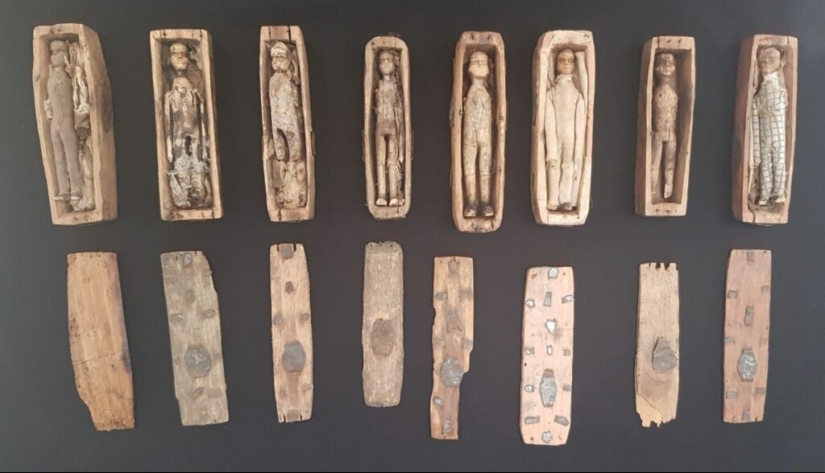The mystery of the 17 wooden dead, which cannot be solved for almost two centuries
Categories: Europe | History | Society
By Pictolic https://pictolic.com/article/the-mystery-of-the-17-wooden-dead-which-cannot-be-solved-for-almost-two-centuries.htmlThe world is full of mysteries that are beyond the control of man. Some of them, such as the secret of the Maya cosmonauts, are familiar to many and excite the minds of thousands of scientists. But there are also less hyped ones, nevertheless also interesting. These include the mystery of 17 wooden corpses found in the vicinity of the Scottish city of Edinburgh in the early 19th century.

In the summer of 1836, a group of boys were playing near a hill in the vicinity of Edinburgh. This place was not easy — for a long time the hill was called the Throne of King Arthur and legends were made about it. The guys found a cave in one of its slopes and decided to explore it. To their surprise, they found 17 miniature coffins in its depths, in which wooden dead dolls rested.

A small hall in the bowels of the cave resembled a crypt. Three niches were carved into its walls, on which small coffins were located. In the two lower recesses, 8 creepy dolls stood in even rows, and in the upper one, as if dominating the rest, there was only one coffin with a figurine. All the wooden dead were different. The master who made them obviously tried to make them look like certain people.
Each doll was dressed in neatly sewn funeral clothes, among which there were also no two identical. It was clear that each miniature dead person symbolized a certain personality. The person who created this toy necropolis put a lot of effort into making the figures look like real people.

When the masses became aware of the strange burial, hypotheses began to be born one after another. Reporters from local publications The Scotsman, The Edinburgh Evening Post and the Caledonian Mercury were particularly zealous. It was thanks to them that the world learned about the secret of the cave under the Throne of King Arthur.
Now many would think that 17 coffins with wooden dead are children's toys. But in 1836, it was impossible to imagine a parent who would order such a horror for his offspring. And who would spend time and effort to achieve such realism, and then also equip a real crypt under the hill.

In the 19th century, most were inclined to believe that a miniature burial was the work of a witch. The Scots have been fighting evil spirits for many centuries and burned many women at the stake. Witch hunts ended relatively recently in those parts, and the memory of them was still fresh.
There was also a romantic version associated with the name of the hill. Someone suggested that the figure in the upper niche symbolized King Arthur, and the rest — his loyal knights. However, no one could explain why it was necessary to create such an installation in the 19th century, and even so far from Wales, where, according to legend, a glorious king ruled.
But the most interesting version was connected with two local scoundrels — Burke and Hare. They were two Irish migrants who committed murders in the vicinity of Edinburgh. The criminals, nicknamed the Westport murderers, picked the pockets of their victims, and the bodies were sold to surgeon Robert Knox for dissection.

When the killers were captured, Hare made a deal with the investigation, thereby saving his life. His partner Burke was hanged, and his body, ironically, was given to the anatomical theater. So, these two killed either 16 or 17 people. It has been suggested that the figures in the coffins represent the victims of Irish robbers.
Maybe someone decided to honor the memory of the dead, who for some reason never rested in the ground. It is also possible that a fan of Burke and Hare was having fun in the cave, who decided to perpetuate their crimes. The version associated with the murderers has become the most popular among local residents.

A little later, another guess appeared. Perhaps the dolls in the coffins depicted local sailors. At the beginning of the 19th century, many seafarers died in the abyss, and their bodies were taken by the sea. Superstitious relatives of the deceased could worry that their loved ones would not find eternal rest without having a grave. It is likely that some of them ordered strange figurines and arranged funerals to satisfy the souls of the dead.
And the figures from the cave under the Throne of King Arthur hill are kept in the museum and still excite the minds of scientists and ordinary visitors.
Recent articles

Jacques-Henri Lartigue (1894-1986) is perhaps the most famous "amateur" in the history of photography. The art world discovered his ...

It turns out that an active lifestyle is useful not only for the body but for the brain. Exercise strengthens muscles and spirit, ...

Most major companies profanity is not encouraged. It is considered that the profanity — it is a sign of disrespect for ...